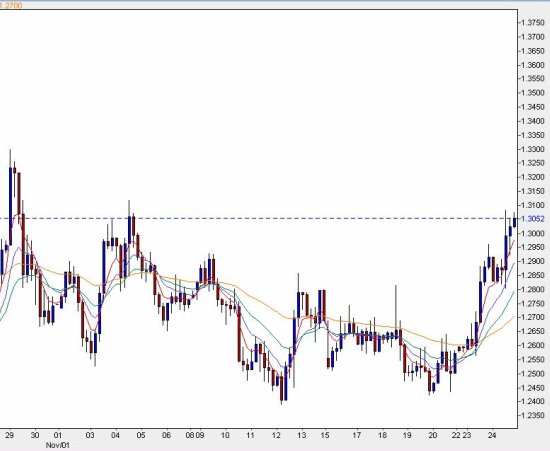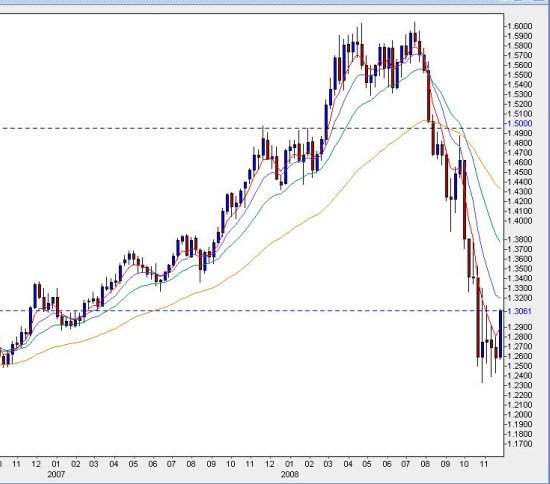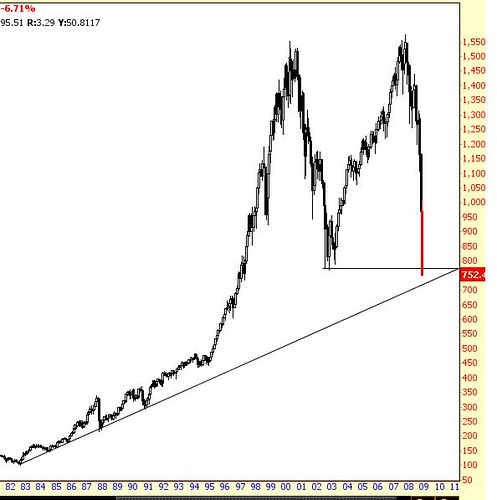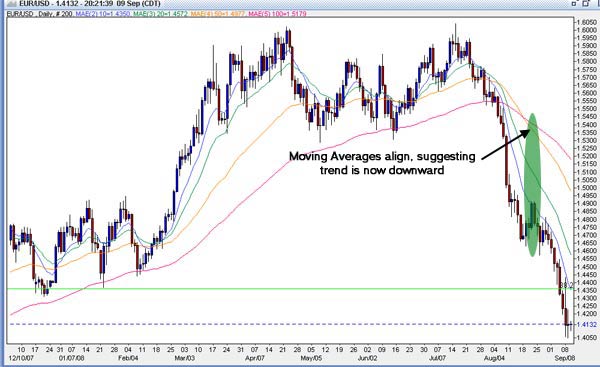Thursday, November 27, 2008
Five Rules of Survival for Private US Companies in the Global Downturn
1. The big picture is the US dollar. As I've stated many times before, the US dollar, its value, and its role as the world reserve currency are at the heart of the current economic crisis. In my opinion, the end result of all these bailouts and collapse of the US financial markets will be currency devaluation, and thus I recommend businesses prepare accordingly.
2. While the US dollar is strong, shop till you drop. The US dollar has been strengthening for much of 2008; while this scenario continues, American private businesses should be looking to acquire. As the currency gets devalued over the next four years, prices will rise and purchasing power will decline. This makes now a great time to go shopping and buy assets that will be needed over the long-term.
3. Consider getting fixed rate credit. Right now, interest rates in the US are very low; they are approaching zero. This, coupled with the expectation of significant currency devaluation going forward, makes borrowing to buy now and pay back later (when the currency is worth less) a compelling strategy. This must be done carefully; only companies that can reasonably manage debt should consider this option. Also, as we have discussed previously, the Federal Reserve may need to raise interest rates to make the debt it continues to issue more attractive.
4. Don't forget to raise prices. Ask anyone who lived through the currency crises in South America: the biggest mistake companies make is failing to raise prices quick enough. Keep an eye on dollar prices and the rate of fluctuation in its value, and move your prices accordingly. Alternatively, if possible, consider pricing in other currencies -- particularly gold or silver. Last but not least, bear in mind that Asian currencies may appreciate while the US dollar declines, particularly if they stop purchasing US Treasuries but direct that wealth instead to domestic production, which China recently took a step towards doing via its stimulus package. As a result, opportunities for American businesses to export to Asia may be a sector to look into.
5. Everyone's a central banker now. Central banks maintain a reserve that is diversified across a number of currencies and precious metals. In a globally volatile economy, businesses must do the same to effectively hedge risk and preserve wealth. Precious metals and foreign currencies are more important than ever.
Discuss this article on InformedTrades
Wednesday, November 26, 2008
EURUSD: The Comeback Kid of the Forex Market?
Looks like I was wrong. EURUSD did shoot out of the descending triangle quickly -- but it did to the upside. So is EURUSD ready to start an uptrend again? Let's see what the charts tell us:
1. The four hour chart shows the moving averages bullishly aligned, Moreover, the three consecutive bullish candles, each with higher lows, and coming following a downtrend, suggests a three white soldiers pattern, which would be a bullish sign.

2. Meanwhile, on the daily chart, we also see the three white soldiers pattern, as well as the moving averages having turned bullish.

3. Lastly, on the weekly chart, we see that the market has been trading in a range for the past few weeks, consolidating its previous sharp moves. Now, though, we see a bullish breakout, as well as a change in direction on the 5 EMA.

Key Levels
If you're looking to go long EURUSD, I'd look for resistance at around 1.3250, with support at 1.2950. A break above the 50 EMA, which is currently at around 1.3250, may suggest a larger reversal of trend is forming.
Fundamental Factors Confirm
We're seeing dollar weakness show up in other markets as well; USDJPY broke south of its descending triangle, and gold has broken above resistance at both $748 and $800. US stock market traders will want to be particularly wary of bull markets at this time; is it really a bull market if it were priced in another currency, like gold?
Long-term I am very bearish on the US dollar, so now seems like there may be an opportunity for dollar bears in the EURUSD market.
Disclosure: No position in EURUSD. Short USDJPY.
Discuss this article on InformedTrades
S&P 500 Heading to 500?

As the chart illustrates, the S&P is approaching a trendline that has been in the making since 1982.
The market may bounce off this trendline, or trade in a range for some time. But consistent with the fundamentally bearish view I have over the long-term, I think this trendline is going to break, and I don't think it will take too long -- within six months, if I had to guess (but of course, traders will let the technicals tell them when to enter).
The viewpoint from the perspective of Austrian economics is that the stock market bubbles created under Greenspan's Federal Reserve are now being deflated. The big run up from 1995 to 2001, as visualized in the chart above, was largely the result of the Fed's lax monetary policy in the early 90s; now, as debts are being eradicated, the stock market is naturally correcting itself and removing the malinvestments and excessively high prices that resulted from such an artificially lax monetary policy. Note the significant downturn in the chart above in 2002 and 2003; this was the market trying to deflate itself, though the Fed intervened again by forcing rates too low and thus resulting in an expansion of the money supply and a reinflation of assets. Now, the Fed is once again trying to to cut rates and re-inflate the market -- but it seems as though no one is buying the debt (at least for now).
A full correction of the Greenspan bubbles would result in the S&P going to at least 500, probably further, in my opinion.
Discuss On InformedTrades
The US Dollar's Five Vital Signs
1. CDS Prices. Credit default swaps (CDS) can be thought of as default insurance; the buyer makes regular payments, and the seller makes a payoff if the credit instrument in question goes into default. When CDS prices rise, that is an indication that the market is pricing in an increase in the likelihood of default risk. The CDS price for 10 year US Treasury bonds has increased by 2500% over the past year. If the market believes the US government will not be able to pay off its debt, or will have difficulty doing so, it introduces concerns about the stability of the dollar, as it increases the likelihood of the Federal Reserve creating more money to pay off US government obligations.
2. US Government Debt and Deficit Spending. The more deficit spending -- meaning spending that is greater than the revenue the government takes in via taxation -- the more treasury bonds the US government will need to issue to raise capital to finance deficit spending. More deficit spending leads to a greater need for debt, which leads to more Treasury bonds being issued; this could lead to an expansion of the money supply and higher CDS prices, particularly if the Fed continues to seek a low interest rate. Currently US government debt is rising rapidly.
3. Fed Funds Rates. To counter the effect of rising CDS prices, the Federal Reserve may seek a higher Fed Funds target rate to make US debt more appealing, and to counter concerns about a weakening dollar. At this point, however, we still see the Federal Reserve moving in the opposite direction -- towards zero percent interest rates.
4. Money Supply Indicators. Monitoring money supply can also give an indication as to how inflationary forces -- attempts at expanding the money supply, which can potentially weaken the US dollar -- vs deflationary forces (money supply contractions resulting from credit destruction) can give us an idea of stability issues related to the US dollar. At this time, one money supply indicator that recently turned downward is MZM. Declines in the money supply often correlate to a strengthening of the currency, though demand for money is also a key issue.
5. TED Spread. The TED Spread measures the difference between the rate on three month US Treasury bonds and the the rate at which banks will lend to each other. A higher TED Spread indicates banks are trying to pull credit out of the market. High TED spreads also result in the market countering the inflationary actions of the Federal Reserve. TED spreads have been volatile this year; they are currently declining, which suggests banks are starting to lend again, which is a factor that can lead to money supply expansion and corresponding potential currency instability.
Discuss this on InformedTrades
Four Investment Opportunities in a Deflationary Market
So what's an optimal portfolio for this bout of deflation look like?
1. Inverse ETFs. For those who love exchange traded funds (ETFs), now is an opportunity for inverse ETFs to shine. Broad indices are set to fall, and hence inverse ETFs -- meaning ETFs that go up when the underlying assets in the ETF go short -- are great for deflation. Ones that have done exceptionally well this year:
MZZ -- Twice the inverse of the S&P MidCap 400 Index. Up 105.75% this year.
SMN -- Twice the inverse of the daily performance of the Dow Jones U.S. Basic Materials index. Up 124.13% this year.
SKF -- Twice the inverse of the Dow Jones Financial Index. This is one of my favorites from a fundamental analysis perspective, and is up 52.44%.
SDS -- Twice the inverse of the S&P 500 Index. Up 85.68% this year.
DXD -- Twice the inverse of the Dow Jones Industrial Average. Up 70.37% for the year.I like all those ETFs, although I personally would feel most comfortable with SKF, as that makes the most economic sense to me.
2. US Dollar. I'm always reluctant to say dollar strength, in light of the terrible fundamentals on the US dollar and my inflationary outlook, though while MZM (money to zero maturity, a money supply indicator) is contracting -- which it currently is -- I think we'll see the dollar strengthen. UUP, the ETF for dollar bulls, is up 10.55% for the year.
3. US Treasuries. I'm still wary of the entire US bond market, and thus would not recommend US treasuries. With that said, it has become apparent traders/investors as a whole are favoring short-term treasuries as a safe-haven. To the extent the market continues to behave this way, treasuries will do well in deflation. I'd urge investors to consider arguments for why the bond market is due for a collapse. As a person who views inflation as a larger concern than deflation, the well-being of the bond market is of particular concern to me, as it could lead to a run on the US dollar.
4. Japanese Yen. My personal favorite, as it is the only thing I've found that can satisfy both inflationists and deflationists. The yen has been rallying along with the US dollar, and has even been rallying faster than the US dollar. FXY, the ETF monitoring the Japanese Yen, is up 14.69% for the year. I expect Yen bullishness to continue, and favor a portfolio diversified across Asian currencies.
What do you think? What's in your ultimate deflation portfolio? Discuss with us at InformedTrades.
Disclosure: I am long Japanese Yen.
Milton Friedman, John Keynes, and Other Foes of Sound Money
Keynesian. John Maynard Keynes is the father of contemporary macroeconomics. I would consider this to be a rather negative claim, given that Keynesian policies are at the heart of our current crisis. According to Keynes, deficit spending is not a problem, and the government should use it when necessary to stimulate the economy. Traditional Keynesian economists are not concerned with price inflation, because they argue that prices will not rise above aggregate demand (i.e. prices will not rise above what people are willing to pay for them). Stagflation is precisely the term for the scenario in which prices begin to rise beyond aggregate demand; witness Zimbabwe, and to a lesser extent, the United States in the late '70s and in 2007.
Regrettably, we still see Keynesian solutions being offered to Keynesian problems. US President-elect Barack Obama has stated that deficit spending should not be feared, and needs to be embraced in the short-term to boost the economy.
Friedmanites. Milton Friedman is not too different from Keynes; the only real difference the most significant difference is that Friedman advocates legislative bodies like Congress regulate the money supply via an agreed upon formula, rather than an independent central bank unbound by formulas. The assumption implicit in this school of economics, though, is that a proper formula can be devised, and that a political body can manage it appropriately without the threat of overwhelming corruption.
Supply-siders. Led by Arthur Laffer and Charles Kadlec, supply-siders argue for watching commodity prices, and then tinkering with the money supply to keep commodity prices stable. In a way, this is similar to the policies championed by Paul Volcker, Federal Reserve chairman during the late '70s. Gold prices were rising dramatically, and Volcker raised interest rates to effectively contract the money supply, strengthen the US dollar, and bring gold prices back down.
Austrians. The Austrian school of economics calls for commodity-backed money. This means that government's job is simply to ensure that each currency certificate can be redeemed for a specific commodity -- typically a precious metal like gold or silver -- and that it is government's role to define the terms of convertibility. The money supply is thus determined by the availability of a commodity. Should the market need to expand the money supply, demand for commodity production will grow. Thus the money supply is regulated by market forces.
What Type of Monetary Policy Can We Expect -- And How to Trade It
I am a strong proponent of the Austrian school of economics, and believe it will result in the most sound monetary system, upon which free market capitalism can best survive and flourish. Though the Fed is pushing interest rates to zero, should the US dollar give back the gains it made in 2008 and should the US government have difficulty finding buyers of its debt at such low rates in a globally weak economy, the result may be the need to raise interest rates sharply, thus bringing about a return to supply-side ideas and Volcker's policies in the '70s (we talked about this previously in our article on bond prices). This would be a bearish argument for gold -- just as we saw gold fall in price after Volcker's Fed raised rates.
Ultimately, though, I think Keynesianism is still the dominant ideology. The ideal result of this would be prolonged deflation, as seen in Japan, though as I've stated before, my larger concern is that this will result in sharp currency devaluation, as seen in Argentina.
Trade accordingly!
Inflation, Deflation, and the Depression
While I am still an inflationist, it is clear we are in a deflationary environment, which I was not expecting; I was simply expecting the ongoing expansion of money supply to find is way into an asset class (stocks, commodities, housing, etc) and push prices up in that asset class, as is normally the case. Instead, the market's attempts at deflation -- at purging the overinvestments and malinvestments that have been created through excessive expansion of the money supply, thus returning money supply to the level that the market demands, have proven to be dominant. This results in falling prices, a rising currency, and deflation. The Federal Reserve has tried to inflate the markets with all its might, as recent money supply calculations suggest, but banks have been refusing to lend that money, and thus the deflationary forces have been winning.
Analyzing Where We're Headed
So how much longer will deflation lasts? Depends on what happens:
1. If the Fed resists the temptation to increase the money supply, it will likely be very sharp but relatively short. The dollar bubble is a 37 year bubble, which started once the dollar fully abandoned the gold standard in 1971. Here in my opinion is an excellent article on the implications of that.
2. If the Fed continues to intervene but deflationary forces prove to be stronger, it will likely be steady deflation for a long time. This is similar to what happened in Japan when the Bank of Japan tried to resist deflation. However, Mike Shedlock chimes in with some key differences if America goes deflationary.
3. If the Fed is able to successfully inflate, it will need to find a market to put a bubble into. Given that the US has terrible economic fundamentals -- GDP is faltering, high private and government debt -- it is hard to foresee a bubble in US markets. Perhaps international markets, like commodities, precious metals, foreign stocks, foreign currencies, etc -- will get an influx of US dollars, thus creating bubbles in those markets. This will result in significant dollar devaluation, as those newly created dollars will just be sold and put into non-US markets. This will push the price of US imports up, and thus will result in lots of price inflation for consumers. It could create an opportunity for US export-based businesses.
4. If the Fed inflates but the market realizes the Fed is just printing with no signs of self-constraint, we'll see hyperinflation. In other words, the Fed will have tried to purge the toxic debt by creating junk money, which devalues everything. Just as banks don't want the toxic debt and are not trading with each other because of it, no one will want "the toxic dollar." In other words, there will be a massive run on the dollar in this scenario, which will send dollar-denominated prices through the roof. This is the Argentina scenario.
My Opinions
I think there's going to be a combination of #3 and #4. It is critical to note, though, that foreign markets are experiencing a similar problem, and they are taking the central banking solution of trying to inflate the solution away. We are seeing bubble-type activities in certain markets, such as the Japanese Yen, evidenced particularly by big moves in EURJPY. Dennis Gartman has stated he views EURJPY as a great indicator of the global economy, which I found to be a compelling insight. EURJPY volatility has been huge of late.
In the US, deflationary forces are winning, as evidenced by the rallying dollar, falling commodity prices, and MZM as a money supply indicator, which economist Stefan Karlsson commented on. Meanwhile, reports of shortages and price suppresion in precious metals markets, and attempts on the part of government to force banks to lend to each other, which Mike Shedlock has commented on, are, on the other hand, inflationary arguments.
I do not expect deflation to be reigning for much longer. Government's desire to inflate markets, which is essentially a way of taxing those who hold the currency of the respective economy and transferring wealth to the recipients of the newly created money, is why I'm generally very biased towards viewing inflation as the primary concern. Bernanke has admitted deflation is not really possible, which suggests he will do whatever it takes to inflate the market. Bernanke has also acknowledged inflation is a tax, so he seems to favor this viewpoint with the knowledge that he is taxing the public. Meanwhile, members of Congress have reported that they were threatened with martial law if they did not pass the Paulson Plan, which was eventually passed. Furthermore, we do not see government spending being cut. So, the diminishing tax base is coming as government spending is increasing, which will either require further inflation of the money supply or the sale of additional US debt. As debt is now largely held by foreign countries with tenuous geo-political relationships with the United States -- namely China and Iran -- there is the possibility of economic warfare; foreign debtholders can refuse to continue buying debt, which would also fuel inflation, as the debt would be paid for through further expansion of the money supply.
The always insightful Agora Financial has stated that they expect oil to go to $50 and then $200 within 36 months. I like that assessment quite a bit.
Thoughts on Trading This Environment
My primary concern is wealth preservation. With that in mind, I'm primarily looking to protect against dollar devaluation. As a result, here's what I'm doing:
1. I'm viewing deflation as a great opportunity to accumulate precious metals. Gold and silver are great hedges against inflation, and even in deflationary environments, they fall less than other asset classes, and thus still offer opportunities for those who own gold and silver to gain purchasing power (i.e. gold and silver may be falling in price, but everything else is falling faster). I don't trade precious metals, but I "invest" in them -- meaning I accumulate them and don't plan on selling until at least a few years out.
2. I'm particularly concerned with dollar devaluation, and thus look for markets in which excess US dollars would find their way into. For a while, EURUSD was great for this. Now the Eurozone clearly has their own problems, though I think Asian currencies are going to pick up some dollars, and thus I've been trading the Yen, and am in a Yen trade now.
In deflationary environments, I'll be trading less, and will largely be out of the market, instead looking for opportunities to accumulate precious metals and cash. If you're into trading deflation, markets where the money supply is being pulled from may prove to be great short opportunities. As money supply contractions have a natural tendency to come from bubble markets, financial instruments and the US housing sector are natural opportunities. For those who believe the US recession of 2002/2003 was not complete -- meaning the NASDAQ bubble was not fully deflated -- US tech stocks may have some room to go down.
As an inflationist, I'll be in foreign currencies and precious metals. I'll buy and hold metals, and will enter currencies when they look bearish for the US dollar, my home currency. I also previously noted some ETFs on the US stock markets that I thought would be worth considering in an inflationary environment.
The Four Corners of Safely Managing Money in a Volatile Economy
It seems like all around the world, we're having some economic problems.
2008 is a year where we saw price inflation on a global basis. We're also seeing a global housing crisis. A global food shortage. And an increase in oil prices around the world.
What is going on here?
While there are many ideas as to what is causing all these problems, one thing is for certain: shortages and price shocks on a global basis require a different approach to wealth management. As one crisis can easily lead to another -- for instance, a rise in global oil prices will increase transportation costs, which in turn will increase prices for everyday goods and services -- there is a serious danger of a "domino effect" of sorts that creates greater economic chaos than most of us have seen in quite some time -- possibly in our life times.
With that in mind, there are four guiding principles individuals should bear in mind when looking to preserve their wealth in a turbulent global economy:
1. Liquidity is Key. Liquidity -- the ease with which you can get in and out of your investments -- is of greater value than ever before. As underlying economic ecosystems are vulnerable, investors should pay extra attention to ensure that they can get in and out of investments as easily as possible. As an example, houses tend to be a bit illiquid; it takes time to buy one, and to sell one. In a deepening housing crisis where the market is overwhelmed with sellers relative to buyers, sellers may be in a particularly dangerous situation; it's a buyers market, and as prices continue to fall, the relatively illiquidity of housing as an investment becomes more apparent and detrimental to one's overall investment portfolio.
2. Short Term Strategies. Related to the idea of liquidity is the notion of short-term investing. For the past few decades, many people, particularly Americans, have grown accustomed to thinking of long-term investing as a safer bet -- i.e. retirement funds, buy and hold strategies with solid companies, etc. In times of economic turbulence, longer term outlooks become harder to forecast. Instead, individuals should look to manage their wealth on a more short-term basis, where one can obtain a more reliable data set upon which to make investment decisions.
3. Technical Analysis. A natural extension of short-term investing is technical analysis -- the decision to base investing decisions based more so on price patterns rather than fundamentals. For instance, a longer term strategy may be to buy stocks of company XYZ, because company XYZ makes a great product and has an experienced and intelligent management staff. Such a strategy may have yielded great results in a more stable economic environment, but in today's more volatile markets, it becomes more important to look at buying and selling activity, and make decisions based on what assets appear to be overbought, oversold, or ready to make a big price increase. Technical analysis may seem like a foreign concept to many, but it is increasingly becoming the primary way professional speculators -- like hedge funds -- participate in the market. The good news is that with the advent of the Internet, an abundance of information, and online trading, learning and successfully applying technical analysis is easier than ever.
4. Diversify on a Macroeconomic Basis. As we noted earlier in this article, one potential cause of concern is for there to be a "domino effect" of crises -- this is why liquidity, short-term strategies, and technical analysis are important. Likewise, so too is the importance of diversifying on an international basis. In other words, as the economy becomes increasingly internationalized, true diversification will mean diversifying across economic ecosystems. One example is currency trading; this allows traders to diversify against currency crises. Another example is investing in commodities -- oil, agricultural products, precious metals, etc -- as these products have a global demand, as opposed to being dependent upon a single ecosystem, as individual stocks and mutual funds generally are. In sum, by embracing these four principles, individuals can find ways to preserve and even enhance their wealth during times of global economic turbulence.
EURUSD Trade Placed on September 5
Below is a weekly chart I used to help identify a strong support level. The area highlighted is a 38.2 Fibonacci level.

I look to the daily chart to confirm that support level, and to wait for the moving averages to align downward as confirmation that the market is trending downward.

I enter on a break of support at 4321. One thing I forgot to include in the chart is the RSI indicator, which I used to check if there was RSI divergence on the break of support. There was no divergence, so I entered.
I'll exit portions of the position once the market begins to retrace and the moving averages begin to reverse.
A Simple Explanation of the Fannie and Freddie Bailout
The bailout of Fannie Mae and Freddie Mac has been all the talk of late in the economics and finance communities, and rightly so. The bailout will have massive economic consequences.
What I feel this means for traders:
1. The US government simply cannot afford the bailout that it has agreed to make. This will mean that the US government via the Federal Reserve will likely have to print more money, which will result in dollar devaluation.
2. While markets did react positively to this news in the short-term, the underlying economics have not changed. There is still too much bad debt going around. As such, I would expect paper assets -- i.e. financial instruments -- to continue falling.
3. With financial assets falling and the US dollar falling, smart money will increasingly go to hard assets and commodities.
As such, I would expect more of the same. Meaning:
1. Dollar devaluation, which will result in price inflation
2. A bullish market for commodities
3. A bearish market for US stocks
These are long-term outlooks -- think years. Recently, we've seen the dollar strengthen a good bit, and we've seen gold prices and oil prices fall; I would view these as momentary corrections in what I feel can only be described as a massive economic downturn. Short-term traders should of course base decisions based on price action and other technical factors, though I personally prefer to know whether I am trading with or against the long-term trend. Below are links to commentary I found to be accurate and insightful regarding the Fannie Mae and Freddie Mac bailout. Given the magnitude of this issue, I recommend traders gather a wide variety of opinions so as to be capable of making their own informed decision.
The Smart Money Tracker: The end of the bear?
Death of Fannie, Freddie Only the Beginning
